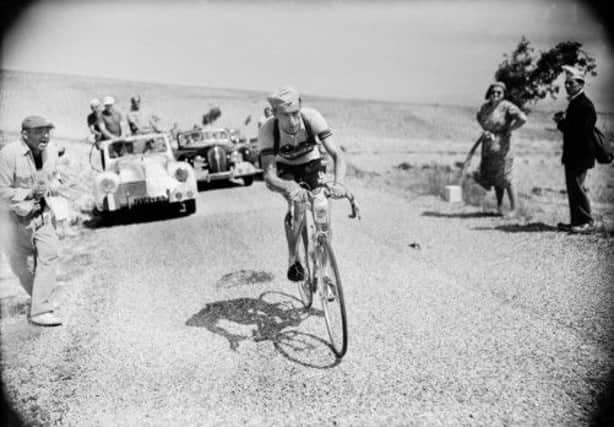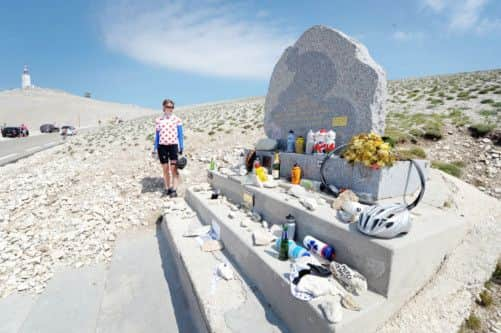Mont Ventoux: Monument to best and worst of the Tour


Twenty-four hours before he would be part of a Tour making its 15th visit to Ventoux, at yesterday’s stage start in Saint-Pourçain-sur-Sioule, David Millar spoke about what makes this mountain so special, so mythical.
“Geographically it’s odd,” said Millar. “It’s not in the middle of a mountain range, it’s there, on its own. It isn’t surrounded by moyennes montagnes; you can see it for miles, which makes it all the more daunting.
Advertisement
Hide AdAdvertisement
Hide Ad“There aren’t many corners, no hairpins to offer some respite. For the first 10km it’s like being on a steep treadmill. And there’s the heat. It’s f*cking hot. It’s in the middle of Provence, so you don’t have that cool mountain air. And there’s the history, the legend of it – it all combines.”


The “Bald Mountain”, or “Giant of Provence”, is certainly more than just a mountain. It is dripping in symbolism and embodies all the paradoxes and contradictions of the Tour de France. The dome-like Ventoux, overlooking the Rhône valley, represents beauty and tragedy, and it is both revered and feared as the scene of heroic acts and despicable deeds.
For instance, the man who until 2004 held the record for the fastest ascent of Mont Ventoux on a bicycle doesn’t really like to talk about it. The man is Jonathan Vaughters, who now runs Millar’s team, Garmin-Sharp, and his performance was in 1999. Until recently Vaughters didn’t spell out why he was so reticent about that ride of his on Ventoux, though most people guessed the reason.
And in autumn last year it all became clear. Vaughters was one of the retired riders who testified against Lance Armstrong to the United States Anti-Doping Agency, allowing USADA to strip the seven-time Tour winner of his titles.
Armstrong and Vaughters had been US Postal team-mates in 1999, when Vaughters set his record with EPO, the banned blood booster, coursing through his veins.
Through his team, Vaughters is now trying to be at the forefront of a new kind of cycling with drug-free competition as its founding principle. But it is appropriate that Mont Ventoux should be the symbol of his “greatest” success as well as the source of his deepest shame, and that the two are so difficult to disentangle.
It is in this way that the mountain embodies the contradictions of the Tour, being the scene of some of the greatest and most awful events, most infamously the death of Britain’s Tom Simpson, exactly 46 years ago yesterday.
It is Simpson’s name, and his death, that makes Mont Ventoux synonymous with drugs, but scroll through the names who have been first to the summit and it can be difficult to tell whether you are looking at a hall of fame or a gallery of rogues.
Advertisement
Hide AdAdvertisement
Hide AdLance Armstrong famously never “conquered” Mont Ventoux, never made it to the summit first, and some cling on to this as though the mountain represents some kind of purity and honour as a result. As though the mountain itself took a stand against Armstrong.
But look at the men who reached the top before him: the late Marco Pantani, who was famously “gifted” the win by Armstrong in 2000, and Richard Virenque, four years after his involvement in the Festina affair, the doping scandal that kicked off all the other doping scandals in 1998. Meanwhile, the rider who bettered Vaughters’ record in 2004 was Iban Mayo – three years before he was kicked off the Tour after testing positive for EPO.
As Millar said, there is something different about Ventoux. Perhaps the fact it rears up from the Provence flatlands without warning: that it isn’t part of a range, not merely one of many mountains in the Alps or Pyrenees. Or that its white upper slopes look from a distance like snow, and up close like the surface of the moon. It is the limestone that gives it this otherworldly quality.
Its place in Tour folklore has its origins in 1951, when Mont Ventoux was included for the first time. But it came of age in 1955, when Louison Bobet took a major step towards winning his third consecutive Tour, and when it was also the scene of a near-tragedy that should have given the race a warning.
As they approached Ventoux, the highly intelligent but hyper-sensitive Bobet rode alongside his brother, Jean, to “whisper that he’s not feeling well, not well at all,” as Jean recounts in his wonderful book, Tomorrow, We Ride. (Jean Bobet had answered his brother’s plea to ride as his domestique having initially turned his back on professional cycling to do a PhD in English literature at the University of Aberdeen. He only lasted a term in the north-east of Scotland before Louison persuaded him to return to cycling.) When Louison told Jean he wasn’t feeling well, Jean was reassured. “Knowing him as I do, that’s a good sign.” And right enough, a little further on, Louison told Jean to ride “on the rivet”, to tee him up for an attack.
But as the road began to climb past the tree line, heading into the white, lunar-like scree of the upper slopes, another of the French riders, Jean Malléjac, collapsed and lost consciousness.
After Malléjac came to, and was taken to hospital, the Tour doctor, Pierre Dumas, issued a warning to the riders: go easy on the amphetamines. He reckoned drugs had caused Malléjac to overdo it. It was an incident that eerily foreshadowed the Tour’s greatest tragedy, also on Ventoux, 12 years later.
Bobet, meanwhile, did attack, and won the stage, though that night his anxieties intensified: he was “done in”, he told his brother. And perhaps he was, for after winning in 1955, he only finished one more Tour.
Advertisement
Hide AdAdvertisement
Hide AdIn 1967, when the Tour re-visited Ventoux, the heat in the morning was so extreme that Dumas said: “If the riders take something today we’ll have a death on our hands.”
And when Simpson collapsed near the summit, with a lethal combination of alcohol and amphetamines in his system, the Tour did have a death on its hands. Dumas refused to sign a burial certificate until an autopsy was arranged: it revealed that Simpson died of a heart attack, and that he had drugs in his system.
The following year’s Tour was billed the Tour de la Santé, the Tour of good health, starting in Vittel. And apart from the fact that Vittel has returned as a sponsor, there are parallels with this year’s race as the Tour attempts yet another re-birth, this time following the protracted Armstrong affair, which finally ended last autumn thanks largely to Vaughters and the other ex-teammates who testified.
Chris Froome, in the yellow jersey going into today’s stage, has said he is “on a mission” to prove you can win the Tour clean. He also says that he wouldn’t even be in contention if it was as dirty as it was in Armstrong’s time. Yet Malléjac’s collapse, 58 years ago, illustrates that doping didn’t begin with Armstrong – and probably didn’t end with him, either.
It is too early to declare this year’s race a Tour de la Santé, but Froome’s success, and Vaughters’ rider Dan Martin’s stage victory in the Pyrenees a week ago, might offer signs that things are changing. Not the Ventoux, though. It is immutable, a contradictory place of epic feats and dastardly deeds, with the mystery sometimes being how to tell one from the other.